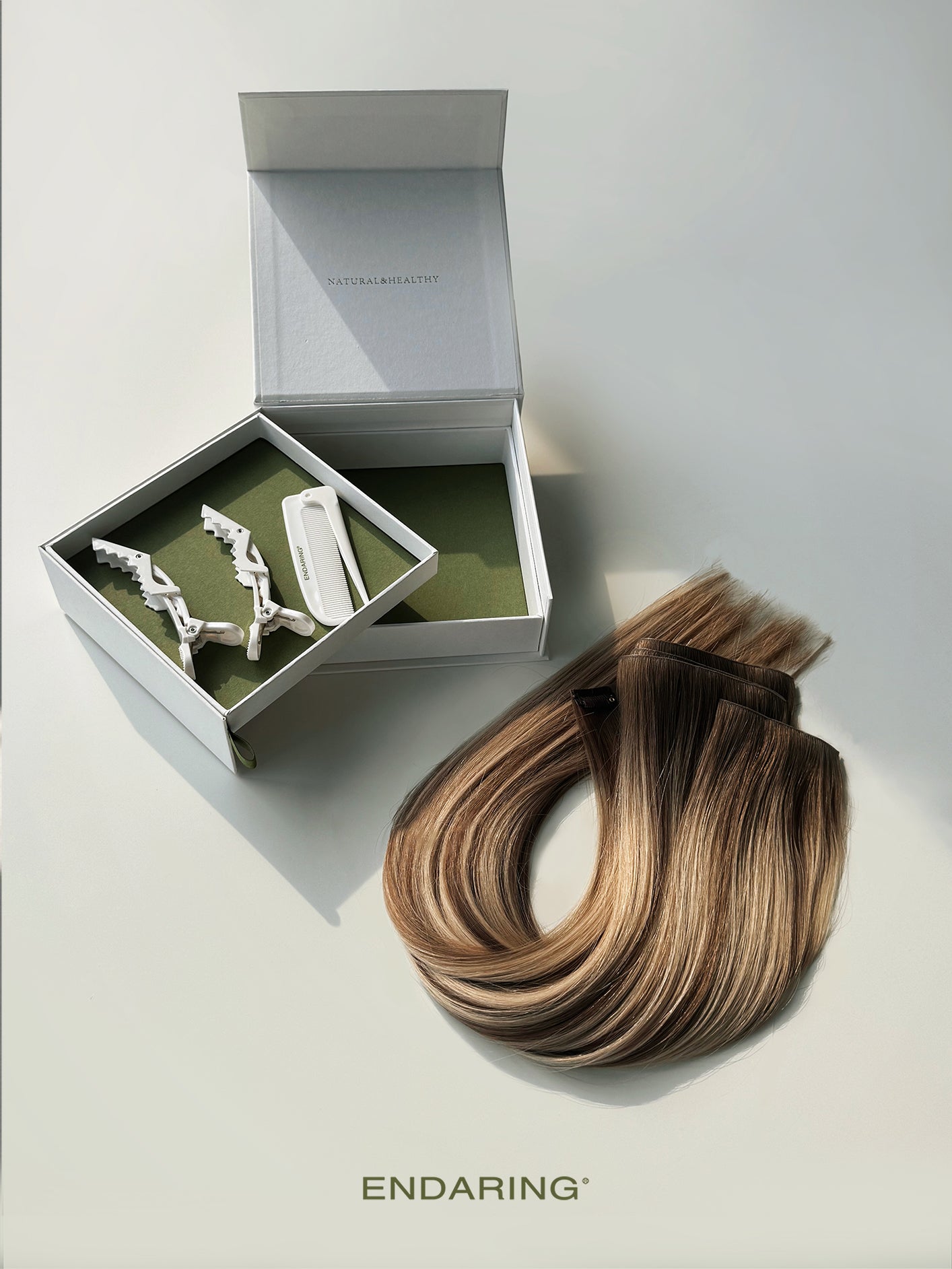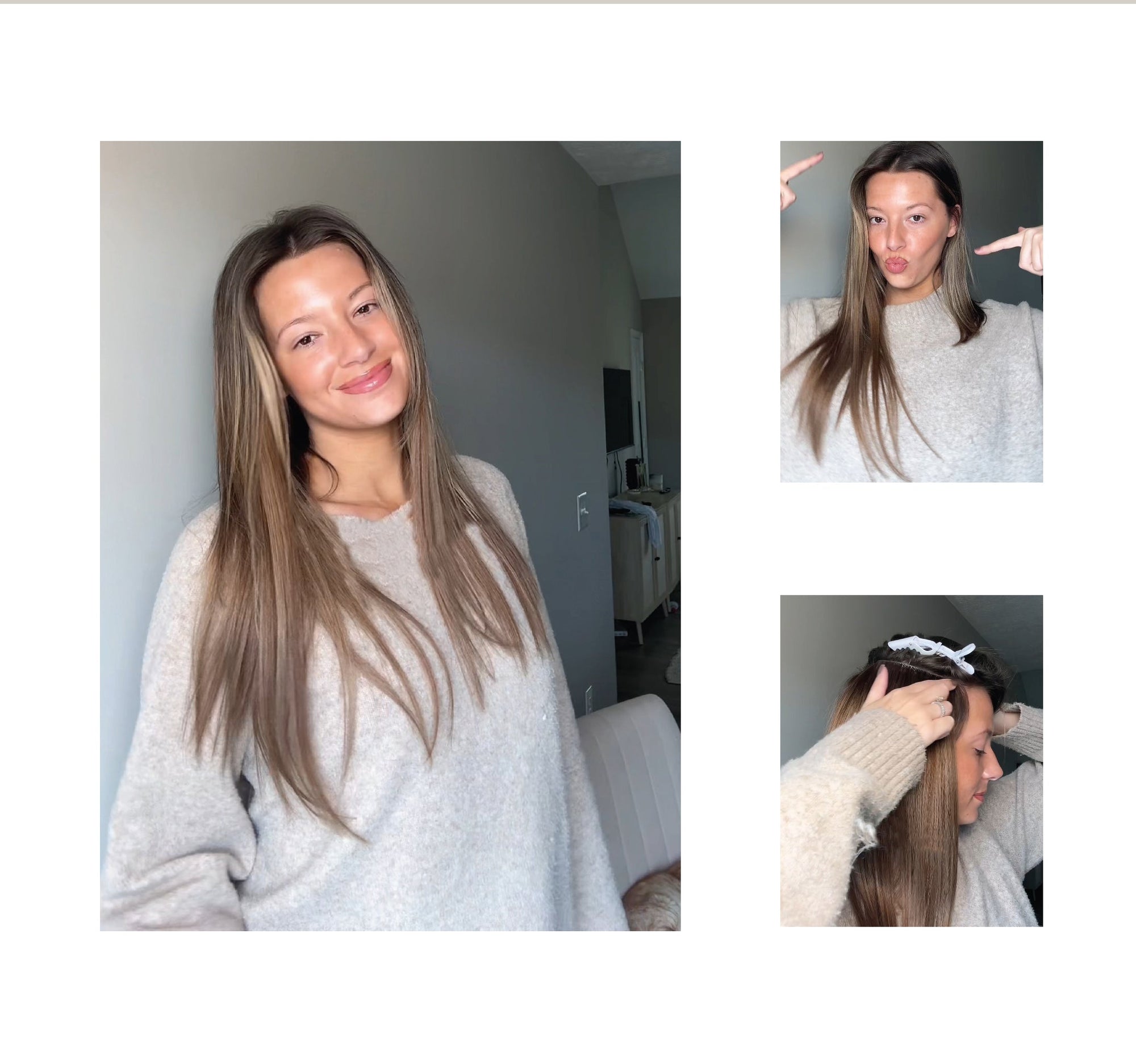First, we must clarify that any type of hair extensions, when used improperly or not cared for correctly, can potentially damage the natural hair. Adhering to the right usage and care methods is crucial to maintaining the health of your hair.
What Are Invisible Tape-In Wefts?
Invisible tape-in wefts have revolutionized the hair extension industry by providing a seamless and natural look. Featuring fewer panels for greater coverage, these extensions allow for quicker and more efficient application, transforming your hair in less time. In under 20 minutes, you can achieve a flawless, voluminous look with a simple DIY application at home. Made from 100% virgin Remy human hair, invisible tape-in wefts ensure the highest quality with no frizz, beautifully holding curls, and lasting longer than many other types of extensions.
When Can Tape-In Weft Extensions Damage Your Hair, and How to Use Them Correctly?
We will analyze potential damage to hair from tape-in weft extensions in two dimensions:
A. Damage During Application
-
Not Washing Your Hair Before Getting Tape-In Weft Extensions Applied
Many people skip deep cleansing of their hair before applying tape-in wefts, going straight to the application. Natural hair that hasn't been properly cleaned may have oils and product buildup, which can compromise the integrity of the adhesive, causing unnecessary pulling and tension on the hair.
Correct Method:
Wash hair thoroughly using a clarifying or cleansing shampoo, with no conditioner. This helps the extensions stay securely in place by removing product buildup and silicones from the hair.
-
Tenderness from Placement Too Close to the Scalp
Tenderness can occur when the wefts are placed too close to the scalp during the initial application. This limits the flexibility of the hair to move, causing discomfort.
Correct Method:
Ensure the wefts are close to the scalp but not so tight that they cause discomfort when the hair moves. The goal is to allow the hair to grow naturally without causing pain until the wefts are slightly loosened over time.
-
Losing Hair When Removing the Extensions
It is normal to shed some hair when removing tape-in extensions. Any hair that would naturally shed on a daily or weekly basis (approximately 50 to 100 hairs daily) gets stuck in the adhesive of the wefts, so it does not come out until the wefts are removed. As a result, you may see more hair shed during the removal process.
If you experience excessive hair loss beyond this normal range, consider checking the method used during removal. Improper removal techniques may lead to excessive shedding. If the hair loss seems unusual, consult a professional.
-
Improper Dissolution of Adhesive, Overuse of Oil or Oil-Based Adhesive Removers, and Incomplete Residue Removal
Failing to fully dissolve the adhesive during removal can cause “rough pulling,” leading to the wefts and natural hair not being completely separated. This can cause healthy hair to be pulled out, resulting in unnatural hair loss and potential scalp inflammation.
Overuse of oil-based adhesive removers can make the hair oily, prolonging the cleaning process. Inadequate cleaning can clog hair follicles, potentially leading to scalp irritation.
Failure to thoroughly remove residue can cause the hair to tangle and knot with the leftover product, leading to unnecessary hair loss.
Correct Method:
Use an alcohol-based remover to dissolve the adhesive, followed by a light application of an oil-based remover to clean any residue. A wide-tooth comb can be used gently to work through any remaining adhesive. Wash hair thoroughly with shampoo, and ensure you apply conditioner to the roots, leaving it on for about 10 minutes. Multiple washes may be necessary to fully remove all the stickiness.
B. Damage from Daily Maintenance
-
Brushing Hair Directly from Roots to Ends
Brushing from roots to ends directly may cause the comb or brush to catch at the weft connections (especially if the extensions have been worn for a while), pulling the extensions and causing unnecessary stress on the scalp and hair.
Correct Method:
Hold the hair gently below the extension connection area with one hand, and use a tangle teaser or soft-bristle brush to gently detangle the hair.
-
Washing and Drying with Head Down
Tipping your head upside down while washing or drying can cause the extensions to tangle, creating unnecessary stress on the scalp and hair.
Correct Method for Washing:
-
Detangle First: Gently brush through the hair with a tangle teaser, starting from the ends and working up to remove any tangles.
-
Shower Only: Always wash your hair in the shower, never in the bath, to allow water to flow naturally.
-
Avoid Tilting Your Head Down: Let the water flow from the top of your head, without scrubbing or rubbing your extensions in a circular motion.
-
Gentle Rinsing: Rinse hair from roots to tips without directly scrubbing the bonds or rings.
Correct Method for Drying:
Keep your head upright and avoid tilting it upside down. Do not wrap your hair in a turban. Instead, wrap it in a towel or air dry. It’s highly recommended to air dry hair to about 50% before blow-drying.
In conclusion, while tape-in weft hair extensions can be a great way to enhance your look, proper application and maintenance are key to preventing any damage. By following the correct steps and caring for your extensions properly, you can enjoy beautiful, healthy hair without compromising its natural integrity. Always remember, when in doubt, consult a professional to ensure your extensions stay in top condition.





